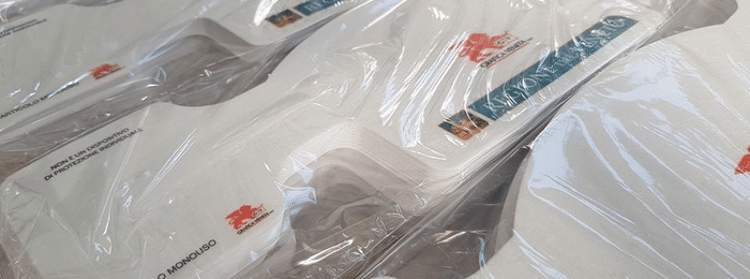Grafica Veneta prepare to produce 'masks' for the public in Veneto

Grafica Veneta, a well-known book printer in Padua, Italy are preparing to produce protective masks for the wider public as currently there is a shortage of personal protective equipment available. They are described not as “protective masks” but instead “protective screens” that cover the mouth and nose of the wearer. Dispersing this to the public will hopefully help to limit the spread of COVID-19.
Grafica Veneta comments: “To call a product a “mask” you need permissions and certifications in order to do so. We hope to obtain these as soon as possible so that we can proceed to mass produce and distribute to the public. Since we are faced with a pandemic, it is vital that we equip the citizens with these protective screens and tools to help lower levels of contamination.”

The President of Veneto, Luca Zaia and CEO of Grafica Veneta, Fabio Francheschi both presented at a press conference on the 18th March 2020 and announced that the Ministry of Health approved the mass production and distribution of the “protective screens” from Grafica Veneta.

The Councillor for Civil Protection, Giampaolo Bottacin, and the Councillor for Health and Social, Manuela Lanzarin, have sent letters to the Venetian towns and to centres of services for the elderly, assisted health residences and housing for the disabled, containing the practical guidance for the distribution of the screens. The letter specifies that the relevant supplies will be delivered to the individual administrations by the Regional Civil Protection and requests that the mayors facilitate widespread distribution. Lanzarin has written to all facilities for the elderly and disabled people, announcing the arrival of the masks. In this case, the distribution will be directly curated by Grafica Veneta.
Grafica Veneta will be able to produce 1 million screens a day; and 2 million screens will be gifted to the Veneto region.
Source Information: this article was written by Stampamedia.
Topics
Interested in joining our community?
Enquire today about joining your local FESPA Association or FESPA Direct
Recent news

The importance of ink for large format printers
Ink is crucial for large format inkjet printers, influencing substrate compatibility, productivity, and cost. Nessan Cleary discusses the three main types which include UV-curable ink, latex ink and eco-solvent ink. Each ink type has specific strengths and weaknesses, making printers choice dependent on budget and intended applications.

What are the benefits of Direct-To-Fabric printing?
Direct-to-fabric printing is gaining popularity for high-volume textile production, enabling on-demand, customized short runs. These printers offer ink flexibility, accommodating various fabric types like cotton and silk, though ink development focuses on faster turnaround by reducing pre- and post-processing. Compared to traditional methods, direct-to-fabric inkjet printing is a more sustainable option due to reduced water and chemical usage, and localized production.

What are the opportunities for large format providers regarding digital touch screens?
Digital touchscreens are becoming increasingly common, offering businesses opportunities to improve customer engagement and streamline operations. Nessan Cleary shares, while more expensive to implement than standard digital displays due to complex software and integration needs, touchscreens provide self-service options, multilingual support, and can reduce staffing costs in various settings like retail, transportation, and healthcare.
